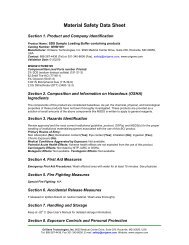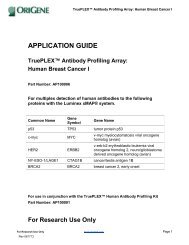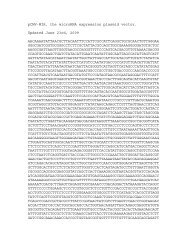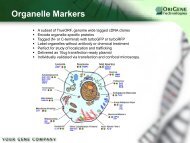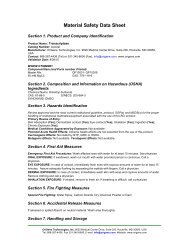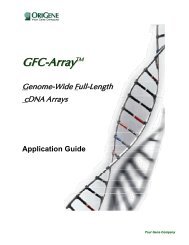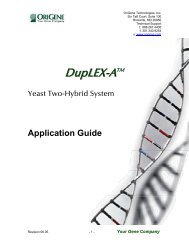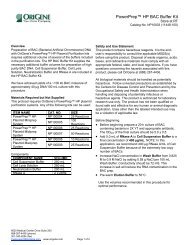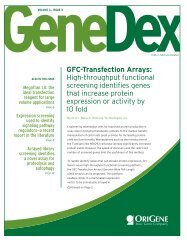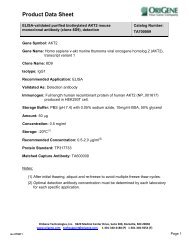shRNA and shRNA vectors - OriGene
shRNA and shRNA vectors - OriGene
shRNA and shRNA vectors - OriGene
You also want an ePaper? Increase the reach of your titles
YUMPU automatically turns print PDFs into web optimized ePapers that Google loves.
2006 Nobel Prize<br />
awarded to RNAi<br />
researchers<br />
The Nobel Assembly at Karolinska Institute has awarded the<br />
Nobel Prize in Physiology or Medicine for 2006 jointly to<br />
Andrew Z. Fire <strong>and</strong> Craig C. Mello for their discovery of “RNA<br />
interference – gene silencing by double-str<strong>and</strong>ed RNA”. This<br />
mechanism of gene expression knockdown has become a valuable<br />
scientific tool in the past nine years, <strong>and</strong> is at the heart of<br />
<strong>OriGene</strong>’s HuSH-29 technology.<br />
In 1998, the American scientists Andrew Fire <strong>and</strong> Craig Mello<br />
published their discovery of a mechanism that degrades mRNA<br />
from a specific gene. This mechanism, RNA interference, is activated<br />
when RNA molecules occur as double-str<strong>and</strong>ed pairs in<br />
the cell. Double-str<strong>and</strong>ed RNA (dsRNA) activates biochemical<br />
machinery, which degrades those mRNA molecules that carry<br />
a genetic code identical to that dsRNA. When such mRNA<br />
molecules disappear, the corresponding gene is silenced <strong>and</strong><br />
no protein of the encoded type is made. RNA interference is<br />
widely used in basic science as a method to study the function<br />
of genes <strong>and</strong> has incredible potential to lead to novel clinical<br />
therapies in the future.<br />
The discovery of RNA interference<br />
Andrew Fire <strong>and</strong> Craig Mello were investigating how gene<br />
expression is regulated in the nematode worm Caenorhabditis<br />
elegans. Injecting sense or antisense mRNA molecules<br />
alone encoding a muscle protein led to no changes in the<br />
behavior of the worms. But when Fire <strong>and</strong> Mello injected sense<br />
<strong>and</strong> antisense RNA together, they observed that the worms<br />
displayed peculiar, twitching movements. (Similar movements<br />
were seen in worms that completely lacked a functioning gene<br />
for the muscle protein.) They theorized that a double-str<strong>and</strong>ed<br />
RNA molecule silenced the gene carrying the same code as<br />
that particular RNA. Fire <strong>and</strong> Mello tested this hypothesis by<br />
injecting into the test animals double-str<strong>and</strong>ed RNA molecules<br />
containing the genetic codes for several other worm proteins.<br />
In every experiment, injection of double-str<strong>and</strong>ed RNA led to<br />
silencing of the gene containing that same sequence.<br />
After a series of simple but elegant experiments, Fire <strong>and</strong><br />
Mello deduced that double-str<strong>and</strong>ed RNA can silence genes,<br />
that this RNA interference is specific for the gene whose code<br />
matches that of the injected RNA molecule, <strong>and</strong> that RNA<br />
interference can spread between cells <strong>and</strong> even be inherited. It<br />
was enough to inject tiny amounts of double-str<strong>and</strong>ed RNA to<br />
achieve an effect, <strong>and</strong> Fire <strong>and</strong> Mello therefore proposed that<br />
RNA interference (now commonly abbreviated to RNAi) is a<br />
catalytic process.<br />
Fire <strong>and</strong> Mello published their findings in the journal Nature<br />
on February 19, 1998. Their discovery clarified many confusing<br />
<strong>and</strong> contradictory experimental observations <strong>and</strong> revealed a<br />
natural mechanism for controlling the flow of genetic information,<br />
heralding the start of a new research field.<br />
New opportunities in biomedical research,<br />
gene technology <strong>and</strong> health care<br />
RNA interference opens up exciting possibilities for use in<br />
gene technology. Double-str<strong>and</strong>ed RNA molecules have been<br />
designed to activate the silencing of specific genes in humans,<br />
animals or plants. Such silencing RNA molecules are introduced<br />
into the cell <strong>and</strong> activate the RNA interference machinery<br />
to break down mRNA with an identical code. <strong>OriGene</strong>’s<br />
HuSH-29 constructs are designed to express these doublestr<strong>and</strong>ed<br />
molecules after transfection into a cellular target.<br />
This method has already become an invaluable research tool<br />
in biology <strong>and</strong> biomedicine. In the future, it is hoped that it will<br />
be used in many disciplines including clinical medicine <strong>and</strong> agriculture.<br />
Several recent publications show successful gene silencing<br />
in human cells <strong>and</strong> experimental animals. For instance,<br />
a gene causing high blood cholesterol levels was recently<br />
shown to be silenced by treating animals with silencing RNA.<br />
Plans are underway to develop silencing RNA as a treatment<br />
for virus infections, cardiovascular diseases, cancer, endocrine<br />
disorders <strong>and</strong> several other conditions.<br />
Adapted from the Nobel Prize press release at http://nobelprize.org/nobel_prizes/medicine/laureates/2006/press.html<br />
Fire <strong>and</strong> Mello’s seminal work led to<br />
the development of many molecular<br />
tools for RNAi, including <strong>OriGene</strong>’s<br />
HuSH-29 constructs.<br />
20



